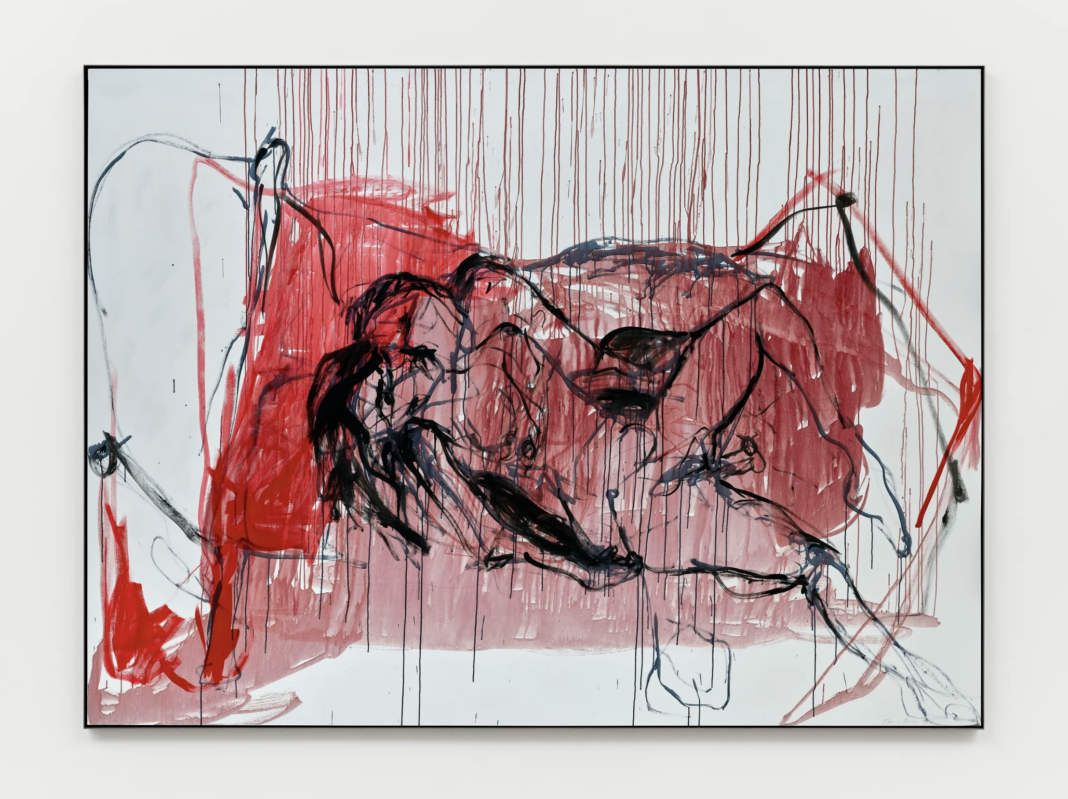The pristine walls of the newly opened Madison Avenue location of White Cube were recently graced by “Lovers Grave,” a showing of Tracey Emin’s new paintings. Ranging in size from giant pieces on the gallery’s first floor, to more diminutive works upstairs, the show provides an immaculate selection of beautiful gestural canvases, each in perfect harmony with itself and its spotless surroundings. Despite their sinister titles (There was Blood; We died Again; The End of Her) and the vermillion and hematite-red paint suggestive of gore and bloody droplets, these paintings seem benign and neat. The aestheticized edifice of the show holds up, even if the viewer knows that the subject matter of these works is drawn from Emin’s 2020 bladder-cancer diagnosis, her extensive surgical treatments, and the subsequent painful recovery. And despite their expressionistic panache and plentiful visual references to the Austrian modernist Egon Schiele, these new paintings are not expressions but representations of suffering.
Emin’s subject matter has always come from her life. She considers no topic too private, or too sensitive, for sharing in an artwork. Her supporters call this “unfiltered, irreverent, raw.” Unfiltered, irreverent, and raw was the tone of her 2005 memoir, Strangeland, an account of becoming, as reported on her White Cube artist page, “a fucked, crazy, anorexic-alcoholic-childless, beautiful woman,” and of Emin’s weekly 2005–09 column about her life published in The Independent. But not everyone appreciated the disclosures: Emin’s critics consider this tone a form of “indulgent primitivism” and count her rejection of personal boundaries as a solipsistic trading in memories—hers, and those of her intimates. Emin’s famous 1995 Everyone I have Ever Slept With (1963–1995), and the 1999 My Bed, which landed her a Turner Prize nomination, are the paragons of such a revealing approach. These daringly provocative installations served not just as archives of a young artist’s life, but also as storyboards of dubious decisions and bohemian squalor. The Emin of the 1990s repeatedly challenged her audience with her “unmentionables.” These overt and personal displays were shocking, but that was her brand: épater les bourgeois.

In “Lovers Grave,” the themes of sex, depression, and drunkenness are supplemented with a new one: the severe medical trauma Emin endured over the past three years. Because of this context, and the copious references to dripping, gushing, and flowing blood, the show brings to mind Frida Kahlo, another female artist whose work documented (and confabulated) the shocking medical details of her own immense physical suffering. Like Kahlo—who wove explicit depictions of her frequent surgeries and prolonged hospital stays into narratives of romantic strife caused by her doggedly unfaithful husband, Diego Rivera—Emin merges the butchery of the operating room with scenes of lovers in bed. But unlike Kahlo’s work, created in obscurity, Emin’s perfectly executed canvases were painted for public consumption and sale. She made them to be shown, and sold, by one of the world’s premier galleries, White Cube, which in 1993 also hosted the then-thirty-year-old Emin’s first solo exhibition, cheekily titled “My Major Retrospective: 1963–1993.”
Writing about Emin in his 1999 monograph on the YBAs (Young British Artists), High Art Lite, the philosopher and critic Julian Stallabrass perceptively observed that Emin’s confessional work loses its strength when elevated into more genteel settings, such as those of an art gallery, where “her raw expression collides with the refined space of the white cube.” He proposed that her work functions best in truly public, unfussy spaces, which reduce the “gap between the work and the implied viewer.” When placed in the “tasteful white boxes,” or “hung on the walls of privileged collectors,” it turns into a set of “conceptual signs of the exercise of elite and knowing taste.” Emin was sensitive to this mismatch too, quipping often about the “privileged class” and its obligatory good manners. She saw her work as being about simple things: “people do fall in love, people do die, people do fuck.” And since this was at odds with “some kind of politeness” applied to art because “art is often meant for a privileged class,” she made her intimate narratives purposefully grating, and vulgar.

This was in the past when Emin’s work was composed of impolite ephemera. “Lovers Grave” suggests that she has finally bridged this gap between these simple things and their elevated settings. Her current narrative vehicles are not empty vodka bottles and discarded prophylactics, but impeccable gestural paintings covered in lapidary strokes and tasteful washes of cold black and alizarin crimson. Even the color palettes leave little space for alienation—these canvases are haptically perfect. Most of the works in the show are constructed in a similar manner: brush marks that imply body contours overlay a background of raw canvas, titanium white, or dove gray. The immediately visible references to Schiele (confirmed by Emin) pull the works in a figurative direction, while the unacknowledged, but obvious, similarities to the Catalan painter Antoni Tàpies, underscore their abstraction. Yet there is no disunity, and notwithstanding the drama of their origins, these paintings are remarkably analgesic.
For Emin, who believes in reincarnation, and whose recovery was pronounced “miraculous” by her own doctors, these new paintings represent a new phase of joy and hope. She is now looking forward, creatively and philanthropically: her legacy project is TEAR (Tracey Emin Artist Residency), a studio complex and artist residency program located in her hometown of Margate in southeastern England. The project is supported through the proceeds of the £2.3 million sale of her 2022 painting Like a Cloud of Blood, a self-exploratory painting that reaffirms the description of Emin as a “vulnerable-tough fighter-victim” first made by Stallabrass a quarter-century ago. Only now her goods are “privileged class” friendly.
A Message from the Editors
Support our crucial work and join us in strengthening the bonds of civilization.
Your donation sustains our efforts to inspire joyous rediscoveries.
Source: newcriterion.com




